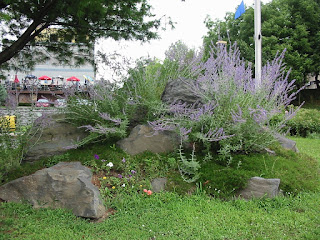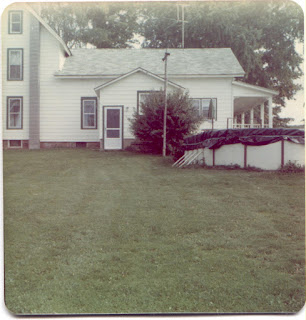 |
| The lavender will soon be blooming again |
|
The weather is
getting better and many of us are thinking of taking trips to further our
research. I know I am looking forward to various trips. NYSCOGO, New York State
Council of Genealogical Organizations is combining their spring meeting with a
trip to the New York State Archives and Library in a couple weeks. I am working
on completing my plans for this trip right now. Whether it is to a library, an
archive, a historical society or someplace else, here are seven tips that are
helpful to make your trip successful.
1-
Check
hours of repository
First things first!
Check and make sure the repository is open when you’re planning on going. What
days are they open and what are the hours? Do they close for certain holidays?
Even obscure ones you’re never heard of are possibilities as they are important
to the local area. Is there a renovation going on that has them unexpectedly
closed? Do you need an appointment to research there?
Check out as much as
you can doing a search of their website and any brochures that you might have.
This will give you a good idea if your plan to go on a certain day is feasible.
Then contact them. Either email or call and double check that they are open
that day and at that time. A bonus to this is that many places will be willing
to pull information for you about your research interest ahead of time and save
you waiting for them to locate that obscure file. One place I visited last
summer was small and crowded with files all over the place, as they didn’t have
room to organize anything properly. However, when I arrived, the files I was
interested in and a few books were neatly stacked on a research table waiting
for me!
 |
| Albany skyline from across the Hudson River |
|
2-
Check
map/directions
Find out where the place is.
Seriously. Don’t assume that just because the historical society is in a small
town that you can find it easily or that everybody knows where it is. For those
of us that don’t use GPS, also don’t assume that everyone can read a map! We
once stopped at a AAA office for help as we had left the map we needed in our
hotel room. The young girl behind the desk tried to help us, but she couldn’t
even figure out how to find the town we were in on the map. Apparently, that
skill is not taught in schools anymore like we were taught.
Have an idea of where you are
headed. Either use GPS or have the directions and a map handy in the car.
Chances are you will miss at least one turn or there will be a detour along the
way that you’ll need to account for.
3-
Check
about parking in the area
Where can you park once you get
there? How much will it cost? Can you use a credit card or is it cash only or
perhaps you need to buy a special card to use in those lots. Smaller places
won’t have as many issues. Often in small towns you can pull into their
driveway or park along the street. However, in larger cities, especially where
the state library and archives are located, parking can be at a premium. Check
out your options and have a two or three in mind in case your first choice is
full.
4-
What
can you bring in there or must leave behind.
Are there restrictions on what
you can bring into the repository? Are laptops allowed? Is a notebook of
research or must you just bring in a few loose sheets of paper? Pens or pencils
only? What about cameras or scanners? Is flash photography allowed-- probably
not. Can you bring a bottle of water in if it is in a secure container?
Archives usually have the most restrictions followed by libraries. Find out
what they are and make sure you don’t bring along anything that isn’t allowed
or that you can secure it somewhere while you are visiting. Many places with
strict restrictions in place have lockers where you can secure your personal
possessions while you’re there. It’s always good to find out ahead of time.
5-
Cost
for research
Is there a fee to research?
Some places charge for the day or by the hour. If you’re a member it might be
cheaper or even free to use the facilities. Find out so you aren’t caught by
surprise. Some places might be exact cash only, for example. Sometimes if
you’re doing a lot of research in one place, it is less expensive to become a
member if only for that year.
6-
Copies
and other restrictions.
Along with the restrictions I
mentioned above, find out what you can copy and how much each copy will cost.
Sometimes you can copy items yourself, other times you’ll need to request copies
and wait for staff to make them. In the latter case, you might have to wait
awhile for the copies, come back another day, or have them sent to you. Find
out ahead of time so that you’re not caught unawares! Along those lines, bring
a camera along if you’re able to. Even if they make copies, photocopiers break
down, and other things happen that might prevent you from getting those copies.
Some places will let you take digital pictures of the items instead. I actually
prefer this method as I have less paper to carry and there is no need to scan
when you get home.
7-
List what you’re researching!
You already started
this didn’t you? Make a list of what you want to look for at this repository.
Which people are you researching that lived in the area that they collect
information about? Create a research plan before you go. It doesn’t have to be
a formal plan like a professional might create. Just list off the things you
are looking for. Check their online catalog or listing of resources. Have the
call numbers written down and other information ready to go. This will save you
a lot of time while you are there.
Along with this, list off your
goals of what you want to accomplish. This will help you stay on track and not
go off on tangents where you find a lot of interesting information, but forget
to look for that very important fact that you were primarily interested in finding
out. Set priorities in case you can’t get to everything that you want to. Alternatively,
it’s also good to have ideas of things that you might like to look for, but
aren’t really necessary in case you get through your list quickly. Be ready to
make the most of the opportunity no matter what you find.

































